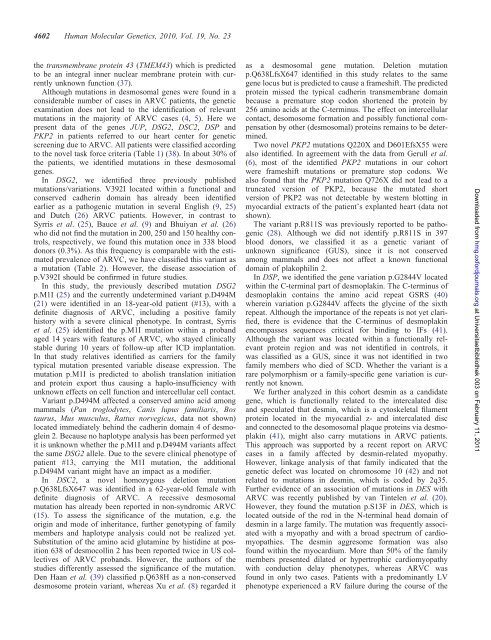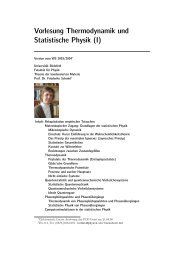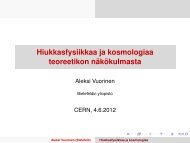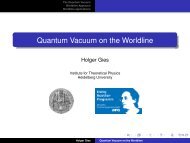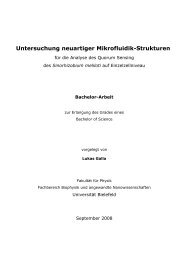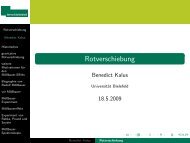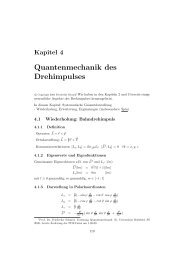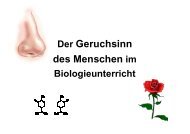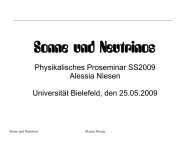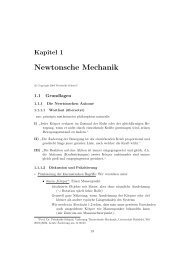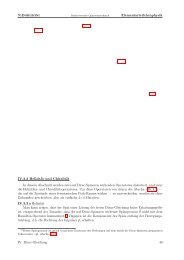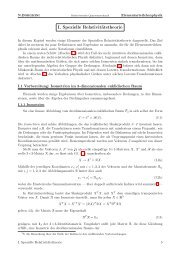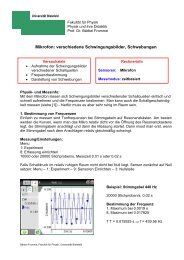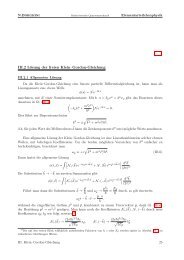De novo desmin-mutation N116S is associated with ... - ResearchGate
De novo desmin-mutation N116S is associated with ... - ResearchGate
De novo desmin-mutation N116S is associated with ... - ResearchGate
You also want an ePaper? Increase the reach of your titles
YUMPU automatically turns print PDFs into web optimized ePapers that Google loves.
4602 Human Molecular Genetics, 2010, Vol. 19, No. 23<br />
the transmembrane protein 43 (TMEM43) which <strong>is</strong> predicted<br />
to be an integral inner nuclear membrane protein <strong>with</strong> currently<br />
unknown function (37).<br />
Although <strong>mutation</strong>s in desmosomal genes were found in a<br />
considerable number of cases in ARVC patients, the genetic<br />
examination does not lead to the identification of relevant<br />
<strong>mutation</strong>s in the majority of ARVC cases (4, 5). Here we<br />
present data of the genes JUP, DSG2, DSC2, DSP and<br />
PKP2 in patients referred to our heart center for genetic<br />
screening due to ARVC. All patients were classified according<br />
to the novel task force criteria (Table 1) (38). In about 30% of<br />
the patients, we identified <strong>mutation</strong>s in these desmosomal<br />
genes.<br />
In DSG2, we identified three previously publ<strong>is</strong>hed<br />
<strong>mutation</strong>s/variations. V392I located <strong>with</strong>in a functional and<br />
conserved cadherin domain has already been identified<br />
earlier as a pathogenic <strong>mutation</strong> in several Engl<strong>is</strong>h (9, 25)<br />
and Dutch (26) ARVC patients. However, in contrast to<br />
Syrr<strong>is</strong> et al. (25), Bauce et al. (9) and Bhuiyan et al. (26)<br />
who did not find the <strong>mutation</strong> in 200, 250 and 150 healthy controls,<br />
respectively, we found th<strong>is</strong> <strong>mutation</strong> once in 338 blood<br />
donors (0.3%). As th<strong>is</strong> frequency <strong>is</strong> comparable <strong>with</strong> the estimated<br />
prevalence of ARVC, we have classified th<strong>is</strong> variant as<br />
a <strong>mutation</strong> (Table 2). However, the d<strong>is</strong>ease association of<br />
p.V392I should be confirmed in future studies.<br />
In th<strong>is</strong> study, the previously described <strong>mutation</strong> DSG2<br />
p.M1I (25) and the currently undetermined variant p.D494M<br />
(21) were identified in an 18-year-old patient (#13), <strong>with</strong> a<br />
definite diagnos<strong>is</strong> of ARVC, including a positive family<br />
h<strong>is</strong>tory <strong>with</strong> a severe clinical phenotype. In contrast, Syrr<strong>is</strong><br />
et al. (25) identified the p.M1I <strong>mutation</strong> <strong>with</strong>in a proband<br />
aged 14 years <strong>with</strong> features of ARVC, who stayed clinically<br />
stable during 10 years of follow-up after ICD implantation.<br />
In that study relatives identified as carriers for the family<br />
typical <strong>mutation</strong> presented variable d<strong>is</strong>ease expression. The<br />
<strong>mutation</strong> p.M1I <strong>is</strong> predicted to abol<strong>is</strong>h translation initiation<br />
and protein export thus causing a haplo-insufficiency <strong>with</strong><br />
unknown effects on cell function and intercellular cell contact.<br />
Variant p.D494M affected a conserved amino acid among<br />
mammals (Pan troglodytes, Can<strong>is</strong> lupus familiar<strong>is</strong>, Bos<br />
taurus, Mus musculus, Rattus norvegicus, data not shown)<br />
located immediately behind the cadherin domain 4 of desmoglein<br />
2. Because no haplotype analys<strong>is</strong> has been performed yet<br />
it <strong>is</strong> unknown whether the p.M1I and p.D494M variants affect<br />
the same DSG2 allele. Due to the severe clinical phenotype of<br />
patient #13, carrying the M1I <strong>mutation</strong>, the additional<br />
p.D494M variant might have an impact as a modifier.<br />
In DSC2, a novel homozygous deletion <strong>mutation</strong><br />
p.Q638LfsX647 was identified in a 62-year-old female <strong>with</strong><br />
definite diagnos<strong>is</strong> of ARVC. A recessive desmosomal<br />
<strong>mutation</strong> has already been reported in non-syndromic ARVC<br />
(15). To assess the significance of the <strong>mutation</strong>, e.g. the<br />
origin and mode of inheritance, further genotyping of family<br />
members and haplotype analys<strong>is</strong> could not be realized yet.<br />
Substitution of the amino acid glutamine by h<strong>is</strong>tidine at position<br />
638 of desmocollin 2 has been reported twice in US collectives<br />
of ARVC probands. However, the authors of the<br />
studies differently assessed the significance of the <strong>mutation</strong>.<br />
<strong>De</strong>n Haan et al. (39) classified p.Q638H as a non-conserved<br />
desmosome protein variant, whereas Xu et al. (8) regarded it<br />
as a desmosomal gene <strong>mutation</strong>. <strong>De</strong>letion <strong>mutation</strong><br />
p.Q638LfsX647 identified in th<strong>is</strong> study relates to the same<br />
gene locus but <strong>is</strong> predicted to cause a frameshift. The predicted<br />
protein m<strong>is</strong>sed the typical cadherin transmembrane domain<br />
because a premature stop codon shortened the protein by<br />
256 amino acids at the C-terminus. The effect on intercellular<br />
contact, desomosome formation and possibly functional compensation<br />
by other (desmosomal) proteins remains to be determined.<br />
Two novel PKP2 <strong>mutation</strong>s Q220X and D601EfsX55 were<br />
also identified. In agreement <strong>with</strong> the data from Gerull et al.<br />
(6), most of the identified PKP2 <strong>mutation</strong>s in our cohort<br />
were frameshift <strong>mutation</strong>s or premature stop codons. We<br />
also found that the PKP2 <strong>mutation</strong> Q726X did not lead to a<br />
truncated version of PKP2, because the mutated short<br />
version of PKP2 was not detectable by western blotting in<br />
myocardial extracts of the patient’s explanted heart (data not<br />
shown).<br />
The variant p.R811S was previously reported to be pathogenic<br />
(28). Although we did not identify p.R811S in 397<br />
blood donors, we classified it as a genetic variant of<br />
unknown significance (GUS), since it <strong>is</strong> not conserved<br />
among mammals and does not affect a known functional<br />
domain of plakophilin 2.<br />
In DSP, we identified the gene variation p.G2844V located<br />
<strong>with</strong>in the C-terminal part of desmoplakin. The C-terminus of<br />
desmoplakin contains the amino acid repeat GSRS (40)<br />
wherein variation p.G2844V affects the glycine of the sixth<br />
repeat. Although the importance of the repeats <strong>is</strong> not yet clarified,<br />
there <strong>is</strong> evidence that the C-terminus of desmoplakin<br />
encompasses sequences critical for binding to IFs (41).<br />
Although the variant was located <strong>with</strong>in a functionally relevant<br />
protein region and was not identified in controls, it<br />
was classified as a GUS, since it was not identified in two<br />
family members who died of SCD. Whether the variant <strong>is</strong> a<br />
rare polymorph<strong>is</strong>m or a family-specific gene variation <strong>is</strong> currently<br />
not known.<br />
We further analyzed in th<strong>is</strong> cohort <strong>desmin</strong> as a candidate<br />
gene, which <strong>is</strong> functionally related to the intercalated d<strong>is</strong>c<br />
and speculated that <strong>desmin</strong>, which <strong>is</strong> a cytoskeletal filament<br />
protein located in the myocardial z- and intercalated d<strong>is</strong>c<br />
and connected to the desomosomal plaque proteins via desmoplakin<br />
(41), might also carry <strong>mutation</strong>s in ARVC patients.<br />
Th<strong>is</strong> approach was supported by a recent report on ARVC<br />
cases in a family affected by <strong>desmin</strong>-related myopathy.<br />
However, linkage analys<strong>is</strong> of that family indicated that the<br />
genetic defect was located on chromosome 10 (42) and not<br />
related to <strong>mutation</strong>s in <strong>desmin</strong>, which <strong>is</strong> coded by 2q35.<br />
Further evidence of an association of <strong>mutation</strong>s in DES <strong>with</strong><br />
ARVC was recently publ<strong>is</strong>hed by van Tintelen et al. (20).<br />
However, they found the <strong>mutation</strong> p.S13F in DES, which <strong>is</strong><br />
located outside of the rod in the N-terminal head domain of<br />
<strong>desmin</strong> in a large family. The <strong>mutation</strong> was frequently <strong>associated</strong><br />
<strong>with</strong> a myopathy and <strong>with</strong> a broad spectrum of cardiomyopathies.<br />
The <strong>desmin</strong> aggresome formation was also<br />
found <strong>with</strong>in the myocardium. More than 50% of the family<br />
members presented dilated or hypertrophic cardiomyopathy<br />
<strong>with</strong> conduction delay phenotypes, whereas ARVC was<br />
found in only two cases. Patients <strong>with</strong> a predominantly LV<br />
phenotype experienced a RV failure during the course of the<br />
Downloaded from<br />
hmg.oxfordjournals.org at Universitaetbibliothek 003 on February 11, 2011


